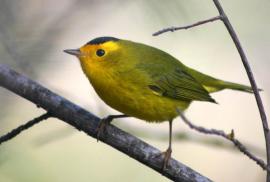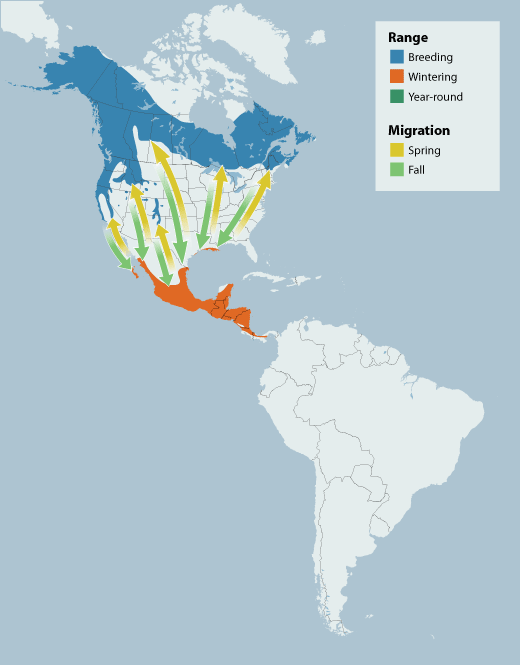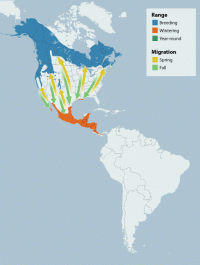Guide to Boreal Birds
This is an in-depth boreal species profile.
What is this?
This species is one of more than 30 birds selected for in-depth profiles. Find out why and see all selected boreal birds »
Overview
Named for naturalist Alexander Wilson, who first described it, Wilson's Warbler is a colorful, widespread, relatively well known warbler of riparian, meadow, and humid forest thickets. Its combined breeding, migration, and wintering ranges cover nearly the entire North American continent. It has become something of a flagship species for the conservation of neotropical migrants and is considered a priority in several conservation plans because of widespread population declines and threats to its habitat.
Description
4 1/2-5" (11-13 cm). Adult male olive green above and yellow below, with black crown patch. Most females and all young birds lack black crown and may be distinguished from other olive green warblers with yellow underparts by lack of wing bars, streaks, tail spots, or other markings.
Voice
A rapid, staccato series of chips, which drop in pitch at the end.
Nesting
4 or 5 brown-spotted white eggs in a bulky mass of leaves, rootlets, and moss, lined with hair and fine plant materials, concealed on the ground in a dense clump of weeds or sedge.
Habitat
Wilson's Warbler is a species of thickets, especially in moist areas such as stream, pond and bog margins and wet forest clearings. Pacific populations also nest in drier habitats including shrubby forest understory, coastal scrub, young tree stands, and other open areas with extensive shrub thickets. Migrants are found in many densely vegetated habitats, even hedgerows and desert scrub. In winter, the species occurs in scrubby, overgrown clearings, coffee plantations, and open woods from hot lowlands to cool mountains. In the highlands of southern Mexico it is often the most numerous forest understory species and it is the only migrant warbler regularly found in alpine grassland.
Range/Migration
Higher counts of Wilson's Warbler in some areas in fall than in spring, and vice versa in other areas, suggest that at least some populations use different routes for spring and fall migration. Additionally, there is evidence that immature birds, at least of coastal populations, follow a more coastal route than adults. Southward migration is from August to October, peaking in early September; northward migration is from March to May. West Coast populations migrate north and south earlier than others, corresponding with their earlier nesting season. Males migrate north ahead of, and perhaps faster than, females to establish breeding territories. Migration is overland and nocturnal. The winter range extends from southern Sonora, southern Baja California, and south Texas to western Panama; a few birds winter in southern Louisiana and along the upper Texas coast. Western breeding populations winter primarily in western Mexico. The winter ecology is extremely flexible; some individuals of both sexes establish territories, some roam widely on their own, and some join mixed-species flocks.
Breeding
The breeding grounds of Wilson's Warbler extend from the eastern Aleutians and the Brooks Range of Alaska across Canada (excluding the extreme north, the prairies, and southern Nova Scotia) into northern New England and extreme northeastern Minnesota. In the West, the range extends down the Pacific coast to south-central California, along the Cascade and Sierra Nevada ranges, and through the northern Rocky Mountains to northeastern Oregon, central Idaho, and the Yellowstone region. There are isolated populations in the mountains of southern California and the Great Basin, the central and southern Rockies, and the Adirondacks. Roughly 75 percent of the breeding range is within the North American boreal forest zone. Wilson's Warbler is primarily territorial and seasonally monogamous, though polygyny (in which a male pairs with more than one female) may be fairly common in montane populations and the possibility of cooperative breeding has been suggested. Although many studies have documented apparent male-biased sex ratios, these may be an artifact of sexual differences in capture probability or migration route, timing, or habitat; or misidentification of females as males, which they closely resemble in western subspecies. Nesting begins as early as March on the West Coast, extending into August in northern regions. The nest is usually on the ground except on the Pacific coast, where nests are usually placed in shrubs or vines. The female does all the nest building and incubation of the two to seven (usually four to six) eggs; clutch size and nest success are higher in the mountains than on the coast. The eggs hatch at 11 to 15 days and the young fledge at 8 to 13 days. One or both parents tend the fledglings for several weeks; some young may stay with one parent while the rest accompany the other. Usually only one brood is attempted, but a few pairs in West Coast populations will attempt a second. Parasitism by Brown-headed Cowbirds (Molothrus ater) is uncommon in most populations but can be very high, even the norm, on the West Coast.
Diet/Feeding Behavior
Wilson's Warbler's diet is typical of the warbler family, consisting mostly of small arthropods but also including a few berries. The principal insects eaten appear to be bees, beetles, and caterpillars, but many others are taken opportunistically. Geographic variation in food preference is likely but not studied. Wilson's Warbler also sometimes eats honeydew produced by scale insects and, in winter, protein corpuscles from leaf bases of cecropia trees. It is an active and versatile forager, using a variety of hunting techniques and moving rapidly through vegetation, usually in shrubs but sometimes (especially in winter) in tall trees and, rarely, on the ground.
References
Ammon, E.M., and W. M. Gilbert. 1999. Wilson's Warbler (Wilsonia pusilla). In The Birds of North America, No. 478 (A. Poole and F. Gill, Eds.). Philadelphia: The Academy of Natural Sciences; Washington, D.C.: The American Ornithologists' Union.
Chase, M.K., N. Nur, and G.R. Geupel. 1997. Survival, productivity, and abundance in a Wilson's Warbler population. Auk 114:354-366.
National Audubon Society. 2002. The Christmas Bird Count Historical Results [Online]. http://www.audubon.org/bird/cbc.
Otahal, C.D. 1995. Sexual differences in Wilson's Warbler migration. J. Field Ornithol. 66:60-69.
Raley, C.M., and S.H. Anderson. 1990. Availability and use of arthropod food resources by Wilson's Warbler and Lincoln's Sparrow in southeastern Wyoming. Condor 92:141-150.
Sauer, J. R., J. E. Hines, and J. Fallon. 2003. The North American Breeding Bird Survey, Results and Analysis 1966-2002, Version 2003.1, USGS Patuxent Wildlife Research Center, Laurel, MD.
Stewart, R.M. 1973. Breeding behavior and life history of the Wilson's Warbler. Wilson Bull. 85:21-30.
Stewart, R.M., R. P. Henderson, and K. Darling. 1977. Breeding ecology of the Wilson's Warbler in the high Sierra Nevada. Living Bird 16:83-102.
Yong, W., D.M. Finch, F.R. Moore, and J.F. Kelly. 1998. Stopover ecology and habitat use of migratory Wilson's Warblers. Auk 115:829-842.
Credits
Birding content provided by National Wildlife Federation/eNature, with support from Ducks Unlimited/The Pew Charitable Trusts.





